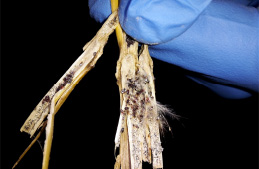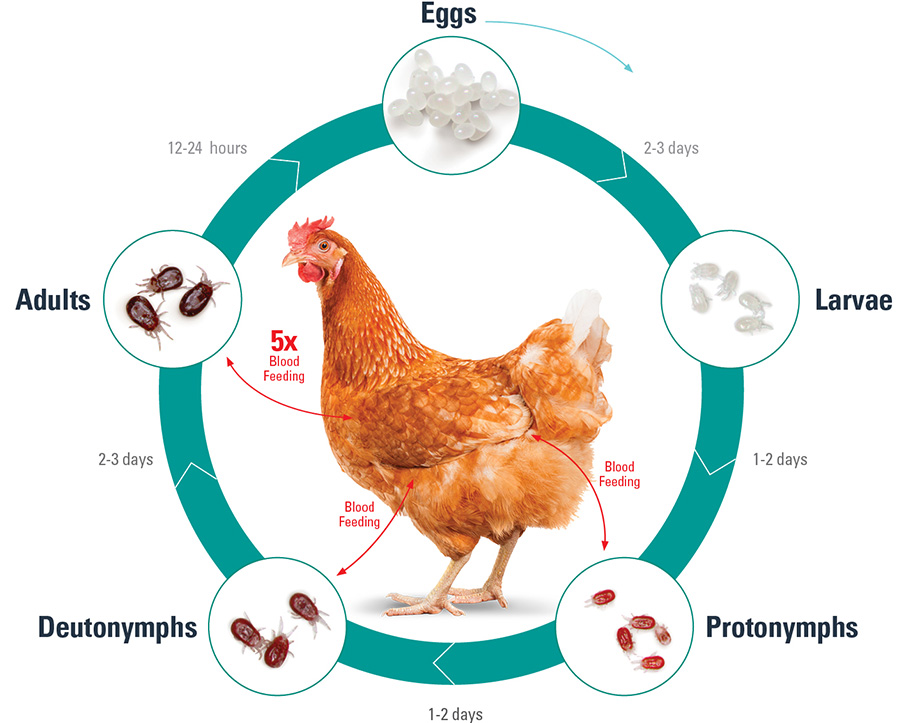

Dermanyssus gallinae
Red mites are the primary mites threatening poultry houses in Europe. These pests can increase rates of anemia, mortality and disease susceptibility while eroding productivity parameters like feed efficiency, egg production, egg quality and weight gain.
In addition to physiological damage, mite parasites are a costly global problem for poultry production. In Europe alone, the approximate total annual cost of red mite infestations totals €360 million, with more than 300 million hens in all production types suffering from infestations.


The Mite Lifecycle
Aside from the egg, poultry red mites have four life-cycle stages: larvae, protonymph, deutonymph and adult. Larvae hatch with six legs and do not feed. After the first molt, both nymphal stages and adults have eight legs. Protonymphs, deutonymphs and adult females routinely feed on host blood, but males only occasionally feed.1, 2, 3
Once on a host, mites feed for short periods of up to an hour, doing so every two to four days and typically during periods of darkness. Complete development of D. gallinae, from egg to adult through one larval stage and two nymphal stages, typically occurs over two weeks.


Based on Sparagano, et. al.3
The life cycle of the poultry red mite, Dermanyssus gallinae.
244,140,625 Problems
If one mite has eight eggs per clutch, in just 12 short weeks you end up with 244,140,625 mites. This little problem can quickly become out of control if not properly handled.
| Week | 4 eggs/clutch | 8 eggs/clutch |
|---|---|---|
| Day 0 | 1 | 1 |
| Week 1 | 3 | 5 |
| Week 2 | 9 | 25 |
| Week 3 | 27 | 125 |
| Week 4 | 81 | 625 |
| Week 5 | 243 | 3,125 |
| Week 6 | 729 | 15,625 |
| Week 7 | 2,187 | 78,125 |
| Week 8 | 6,561 | 390,625 |
| Week 9 | 19,683 | 1,953,125 |
| Week 10 | 59,049 | 9,765,625 |
| Week 11 | 177,147 | 48,828,125 |
| Week 12 | 531,441 | 244,140,625 |
How to Protect Your Poultry and Profits
As the temperature rises this summer, so does the threat of Poultry Red Mite infestations. The warm weather creates prime conditions (10-35˚C and 70% humidity) for infestations to grow rapidly, posing health threats for birds and humans and economic risks for poultry producers.
1 Chauve C. The poultry red mite Dermanyssus gallinae (De Geer, 1778): current situation and future prospects for control. Vet Parasitol 1998; 79:239-245.
2 Carter E, Gillett-Kaufman JL. Chicken mite (other common names: poultry red mite, roost mite) Dermanyssus gallinae (De Geer) (Arachnida: Acari: Dermanyssidae). Document EENY611, UF/IFAS Extension, Gainesville, FL. December 2014. http://edis.ifas.ufl.edu/in1070 (accessed August 2016).
3 Sparagano O.A.E., George D.R., Harrington D.W.J., Giangaspero A. Significance and control of the poultry red mite Dermanyssus gallinae. Annu Rev Entomol 2014; 59:447-466.

A secure house is a clean house.
Many factors contribute to the introduction and spread of poultry red mites.
Avoid the damages caused by infestations with a farm biosecurity audit.
